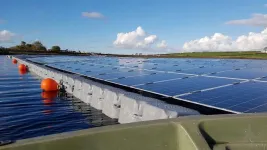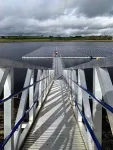(Press-News.org) Floating solar photovoltaic panels could supply all the electricity needs of some countries, new research has shown.
The study, by researchers from Bangor and Lancaster Universities and the UK Centre for Ecology & Hydrology, aimed to calculate the global potential for deploying low-carbon floating solar arrays. The researchers calculated the daily electrical output for floating photovoltaics (FPV) on nearly 68,000 lakes and reservoirs around the world, using available climate data for each location.
The researchers’ calculations included lakes and reservoirs where floating solar technology is most likely to be installed. They were no more than 10km from a population centre, not in a protected area, didn’t dry up and didn’t freeze for more than six months each year. The researchers calculated output based on FPV covering just 10% of their surface area, up to a maximum of 30 km2.
While output fluctuated depending on altitude, latitude and season, the potential annual electricity generation from FPV on these lakes was 1302 terawatt hours (TWh), around four times the total annual electricity demand of the UK.
The findings are published today [4 June 2024] in Nature Water.
FPV have a number of additional advantages over land-based solar installations: they free up land for other uses and they keeps panels cooler, making them more efficient.
There is some evidence for other environmental benefits, including reducing water loss through evaporation, by sheltering the lake surface from the sun and wind; and reducing algal blooms by limiting light and preventing nutrient circulation. However, the researchers warn that further research is needed on the overall environmental impact of FPV. They suggest that decisions to deploy FPV should consider the intended function of water bodies and how they are used, as well as the potential ecological impact.
Lead author of the paper, Dr Iestyn Woolway of Bangor University said: “We still don’t know exactly how floating panels might affect the ecosystem within a natural lake, in different conditions and locations. But the potential gain in energy generation from FPV is clear, so we need to put that research in place so this technology can be safely adopted. We chose 10% of a lake’s surface area as a likely safe level of deployment, but that might need to be reduced in some situations, or could be higher in others.”
When the figures were considered country-by-country, five nations could meet their entire electricity needs from FPV, including Papua New Guinea, Ethiopia and Rwanda. Others, such as Bolivia and Tonga, would come very close, respectively meeting 87% and 92% of electricity demand.
Many countries, mainly from Africa, the Caribbean, South America and Central Asia, could meet between 40% and 70% of their annual electricity demand through FPV. In Europe, Finland could meet 17% of its electricity demand from FPV and Denmark, 7%.
The UK could produce 2.7 TWh of electricity each year from FPV, the researchers found. While this is just under 1% of overall electricity demand, it would provide electricity for around one million homes, based on the current Ofgem estimate of average electricity usage per household of 2,700 kWh.
There are currently very few FPV installations in the UK, with the largest a 6.3MW floating solar farm on the Queen Elizabeth II reservoir, near London.
Dr Woolway said: “Even with the criteria we set to create a realistic scenario for deployment of FPV, there are benefits across the board, mainly in lower income countries with high levels of sunshine, but also in Northern European countries as well. The criteria we chose were based on obvious exclusions, such as lakes in protected areas, but also on what might reduce the cost and risks of deployment.”
Co-author Professor Alona Armstrong of Lancaster University said: “Our work shows there is much potential for FPV around the world. But deployments need to be strategic, considering the consequences for energy security, nature and society, as well as Net Zero.”
The research is funded by the Natural Environment Research Council, part of UK Research and Innovation.
Floating solar photovoltaic panels could supply all the electricity needs of some countries, new research has shown.
The study, by researchers from Bangor and Lancaster Universities and the UK Centre for Ecology & Hydrology, aimed to calculate the global potential for deploying low-carbon floating solar arrays. The researchers calculated the daily electrical output for floating photovoltaics (FPV) on nearly 68,000 lakes and reservoirs around the world, using available climate data for each location.
The researchers’ calculations included lakes and reservoirs where floating solar technology is most likely to be installed. They were no more than 10km from a population centre, not in a protected area, didn’t dry up and didn’t freeze for more than six months each year. The researchers calculated output based on FPV covering just 10% of their surface area, up to a maximum of 30 km2.
While output fluctuated depending on altitude, latitude and season, the potential annual electricity generation from FPV on these lakes was 1302 terawatt hours (TWh), around four times the total annual electricity demand of the UK.
The findings are published today [4 June 2024] in Nature Water.
FPV have a number of additional advantages over land-based solar installations: they free up land for other uses and they keeps panels cooler, making them more efficient.
There is some evidence for other environmental benefits, including reducing water loss through evaporation, by sheltering the lake surface from the sun and wind; and reducing algal blooms by limiting light and preventing nutrient circulation. However, the researchers warn that further research is needed on the overall environmental impact of FPV. They suggest that decisions to deploy FPV should consider the intended function of water bodies and how they are used, as well as the potential ecological impact.
Lead author of the paper, Dr Iestyn Woolway of Bangor University said: “We still don’t know exactly how floating panels might affect the ecosystem within a natural lake, in different conditions and locations. But the potential gain in energy generation from FPV is clear, so we need to put that research in place so this technology can be safely adopted. We chose 10% of a lake’s surface area as a likely safe level of deployment, but that might need to be reduced in some situations, or could be higher in others.”
When the figures were considered country-by-country, five nations could meet their entire electricity needs from FPV, including Papua New Guinea, Ethiopia and Rwanda. Others, such as Bolivia and Tonga, would come very close, respectively meeting 87% and 92% of electricity demand.
Many countries, mainly from Africa, the Caribbean, South America and Central Asia, could meet between 40% and 70% of their annual electricity demand through FPV. In Europe, Finland could meet 17% of its electricity demand from FPV and Denmark, 7%.
The UK could produce 2.7 TWh of electricity each year from FPV, the researchers found. While this is just under 1% of overall electricity demand, it would provide electricity for around one million homes, based on the current Ofgem estimate of average electricity usage per household of 2,700 kWh.
There are currently very few FPV installations in the UK, with the largest a 6.3MW floating solar farm on the Queen Elizabeth II reservoir, near London.
Dr Woolway said: “Even with the criteria we set to create a realistic scenario for deployment of FPV, there are benefits across the board, mainly in lower income countries with high levels of sunshine, but also in Northern European countries as well. The criteria we chose were based on obvious exclusions, such as lakes in protected areas, but also on what might reduce the cost and risks of deployment.”
Co-author Professor Alona Armstrong of Lancaster University said: “Our work shows there is much potential for FPV around the world. But deployments need to be strategic, considering the consequences for energy security, nature and society, as well as Net Zero.”
The research is funded by the Natural Environment Research Council, part of UK Research and Innovation.
END
Some countries could meet their total electricity needs from floating solar panels, research shows
Floating solar photovoltaic panels could supply all the electricity needs of some countries, new research has shown.
2024-06-04
ELSE PRESS RELEASES FROM THIS DATE:
Population shifts, risk factors may triple U.S. cardiovascular disease costs by 2050
2024-06-04
Embargoed until 4 a.m. CT/5 a.m. ET Tuesday, June 4, 2024
DALLAS, June 4, 2024 — Driven by an older, more diverse population, along with a significant increase in risk factors including high blood pressure and obesity, total costs related to cardiovascular disease (CVD) conditions are likely to triple by 2050, according to projections from the American Heart Association, observing 100 years of lifesaving service as the world’s leading nonprofit organization focused on heart and brain ...
5-minute test leads to better care for people with dementia in the primary care setting
2024-06-04
June 4, 2024—(BRONX, NY)—The underdiagnosis of dementia, especially among Black and Hispanic patients, is a long-standing challenge in medicine. A new study, published today in Nature Medicine, finds that an easy, five-minute assessment paired with recommendations built into the electronic medical record system led to a three-fold improvement in diagnosis and treatment for patients in a primary care setting compared to a control group. The “5-Cog paradigm,” which was developed by researchers at Albert Einstein College of Medicine and Montefiore Health System, dramatically enhances ...
Wearable brain imaging gives clearest ever picture of children’s developing brain
2024-06-04
New research has given the clearest ever picture of young children’s developing brains, using a wearable brain scanner to map electrical brain activity. The work opens up new possibilities for tracking how critical developmental milestones, like walking and talking, are underpinned by changing brain function, and how neurodevelopmental conditions like autism emerge.
The research team, led by scientists from the University of Nottingham’s School of Physics and Astronomy, used a novel design of magnetoencephalography ...
Taking care of caregivers of children with ADHD
2024-06-04
Attention deficit hyperactivity disorder (ADHD) is a common neurodevelopmental disorder characterized by elevated levels of inattention, impulsivity, and hyperactivity that can impair academic and social functioning. ADHD is also associated with increased levels of parenting stress, less effective parenting practices, and can disrupt the parent-child relationship. The importance of support for parents of children with ADHD is widely acknowledged in Japan, but specialized parent training programs targeting ADHD have not been available.
However, a new program developed at the Okinawa Institute of Science and Technology (OIST) aims to reduce the strain on families ...
Florida infection preventionist successfully advocates for staff growth, keeping pace with hospital’s expanding service lines
2024-06-04
San Antonio, Texas, June 4, 2024 – In an era of hospital budget cuts and staffing freezes, a Florida hospital more than doubled staff positions for infection prevention and control (IPC) over a four-year period, reducing infections and creating opportunities for non-clinical team members to enter the field and excel.
By presenting a business case showing costs of excess healthcare-associated infections (HAIs), infection preventionist (IP) Luz Caicedo, MPH, CPH, CIC, CRCST, VA-BC at AdventHealth in Celebration, Florida was able to increase IPC staff from 2 to 4.8 ...
Surgical site infection rates and other secondary outcomes decrease dramatically at multi-state hospital system through standardized, preoperative, surgical, antibiotic practices
2024-06-04
San Antonio, Texas, June 4, 2024 – Mortality, length of stay, readmissions, and surgical site infections (SSI) all declined after a six-state hospital system implemented a comprehensive surgical site infection (SSI) prevention bundle, according to a report presented today at the 2024 APIC Annual Conference.
Banner Health, which operates facilities in Arizona, California, Colorado, Nebraska, Nevada, and Wyoming, reported on the impact of a surgical antimicrobial prophylaxis (SAP) bundle on more than 57,000 surgical cases from January 2019 to December 2023. Four publicly reportable procedures ...
Videoconferencing gets older adults moving as health lessons put to practical use
2024-06-04
The COVID-19 pandemic made videoconferencing software commonplace in businesses and even schools, but this communication tool has the potential to offer benefits beyond the office or classroom. An Osaka Metropolitan University-led research team has been exploring how videoconferencing can improve the health of older adults living in the countryside.
OMU Associate Professor Kazuki Uemura of the Graduate School of Rehabilitation Science and colleagues devised a 12-week health education program conducted using the videoconferencing software Zoom, with the aim of having participants engage in active learning. A control group was provided a similar 12-week ...
The importance of a disturbed lipid metabolism in Charcot-Marie-Tooth disease
2024-06-04
Leuven, 4 June 2024 - Charcot-Marie-Tooth disease (CMT), a group of heritable disorders that affect the peripheral nerves, is marked by specific genetic changes. Research by the team of Prof. Ludo Van Den Bosch (VIB-KU Leuven) now reveals the effects of one such genetic cause. They found that the duplication of the gene PMP22 causes problems in the cell membrane of Schwann cells that provide the insulating cover for nerves. The results appeared in the journal Brain.
Gene duplication in CMT1A
Charcot-Marie-Tooth disease is a group of inherited disorders ...
Soft X-ray absorption spectroscopy analysis of isolated water molecules within aqueous acetonitrile solutions
2024-06-04
Herein, the O K-edge X-ray absorption spectroscopy (XAS) profile of an aqueous acetonitrile solution presented a distinct sharp peak not commonly observed in the corresponding profile of liquid water. Inner-shell calculations coupled with molecular dynamics simulations revealed that this sharp peak originated from isolated water molecules surrounded by acetonitrile molecules, rather than from water clusters. Hence, O K-edge XAS could facilitate the electronic-structural analysis of isolated water molecules, differentiating their contributions ...
US pre-teens discover rare juvenile Tyrannosaurus rex; Science expedition chronicled in extraordinary documentary
2024-06-04
Marmarth, ND – Three keen-eyed young fossil hunters made the discovery of a lifetime when they found the remains of a rare teenage Tyrannosaurus rex that could rewrite history, scientists and filmmakers announce today.
The boys -- brothers Liam and Jessin Fisher, 7 and 10 years old at the time, and their 9-year-old cousin, Kaiden Madsen -- spotted a large fossilized leg bone on a walk in the Hell Creek badlands area of North Dakota on July 31, 2022.
Believing they had found a relatively common duckbill dinosaur, they sent a photo to family friend and Marmarth native Dr. Tyler Lyson, Associate Curator of Vertebrate Palaeontology at the Denver ...
LAST 30 PRESS RELEASES:
Space computing power networks: a new frontier for satellite technologies
Experiments advance potential of protein that makes hydrogen sulfide as a therapeutic target for Alzheimer’s disease
Examining private equity’s role in fertility care
Current Molecular Pharmacology achieves a landmark: real-time CiteScore advances to 7.2
Skeletal muscle epigenetic clocks developed using postmortem tissue from an Asian population
Estimating unemployment rates with social media data
Climate policies can backfire by eroding “green” values, study finds
Too much screen time too soon? A*STAR study links infant screen exposure to brain changes and teen anxiety
Global psychiatry mourns Professor Dan Stein, visionary who transformed mental health science across Africa and beyond
KIST develops eco-friendly palladium recovery technology to safeguard resource security
Statins significantly reduce mortality risk for adults with diabetes, regardless of cardiovascular risk
Brain immune cells may drive more damage in females than males with Alzheimer’s
Evidence-based recommendations empower clinicians to manage epilepsy in pregnancy
Fungus turns bark beetles’ defenses against them
There are new antivirals being tested for herpesviruses. Scientists now know how they work
CDI scientist, colleagues author review of global burden of fungus Candida auris
How does stroke influence speech comprehension?
B cells transiently unlock their plasticity, risking lymphoma development
Advanced AI dodel predicts spoken language outcomes in deaf children after cochlear implants
Multimodal imaging-based cerebral blood flow prediction model development in simulated microgravity
Accelerated streaming subgraph matching framework is faster, more robust, and scalable
Gestational diabetes rose every year in the US since 2016
OHSU researchers find breast cancer drug boosts leukemia treatment
Fear and medical misinformation regarding risk of progression or recurrence among patients with breast cancer
Glucagonlike peptide-1 receptor agonists and asthma risk in adolescents with obesity
Reviving dormant immunity: Millimeter waves reprogram the immunosuppressive microenvironment to potentiate immunotherapy without obvious side effects
Safety decision-making for autonomous vehicles integrating passenger physiological states by fNIRS
Fires could emit more air pollution than previously estimated
A new way to map how cells choose their fate
Numbers in our sights affect how we perceive space
[Press-News.org] Some countries could meet their total electricity needs from floating solar panels, research showsFloating solar photovoltaic panels could supply all the electricity needs of some countries, new research has shown.









